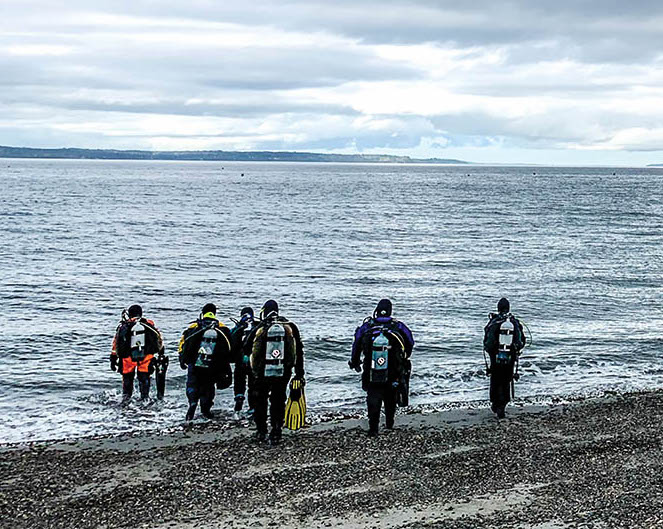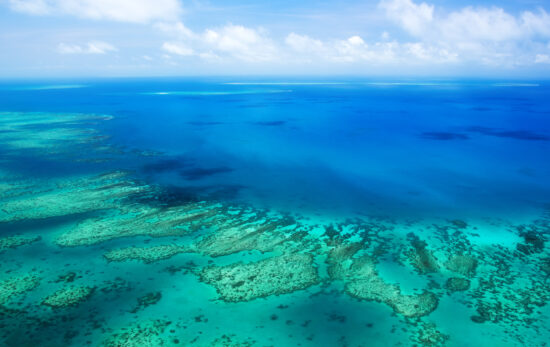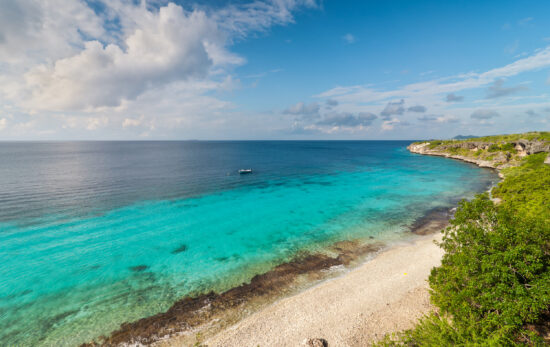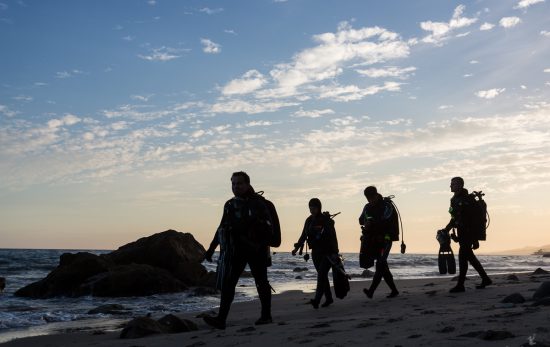Being competent and confident in shore diving opens up the diving world—wherever you choose to slip below the surface, the methods of shore diving remain the same. You have to understand local dive conditions, consider special equipment, and be prepared to enter and exit the water safely. Although I love liveaboard diving because you travel to remote locations, some of the best dives of my life are accessible from shore, and the underwater naturalist in me appreciates being able to dive the same location over and over, at any time of day or night.
When choosing your next dive resort, make sure you ask about their house reef. Often boat dives are scheduled just a few times a day, but the house reef may be open to you 24/7. I’ve filmed mating cuttlefish, frogfish feeding, coral spawning and so many other great behaviors diving from shore, yet many divers underestimate shore-diving opportunities.

Know Before You Go
Before heading out for a shore dive, whether it’s local or an exotic destination, you’ll want to research conditions. What kind of facilities are available? Should you carpool? Will you have cell service for emergencies? Download apps including tides, weather and wind to help you navigate conditions. Popular and even remote dive sites often have online maps available. Read about dive site conditions and potential hazards to help you prepare mentally and physically for shore diving. Pay particular attention to information about local tides and currents. Dive conditions change with the seasons—pay attention to time of year.
Moon cycle impacts tides at different times of the month and year. There are many documented local dive sites in the Pacific Northwest, Florida, California and other areas of the world, with an abundance of scuba diving opportunities year-round for all levels of divers.
Some shore-diving sites are best for beginners. At others you’ll need to plan a dive around slack, ebb or flood tide. When heading to a resort with a great house reef, treat shore diving with respect for your diving level. As a beginner, you do not want to guess. I recommend taking a Discover Local Diving program every time you change environmental conditions and dive sites. Hire a local dive professional for your first shore-dive experience in a new location, and consider a navigation specialty class.
Equipment and Safety
When heading out for local shore diving, create a checklist of dive and safety equipment needed, including tanks, weights, BCD, regulator, charged computer, dive lights, mask, fins, snorkel, boots, oxygen kit, dive flag, compass and delayed surface marker buoy. I also recommend boots for protecting your feet from rocks, urchins and other unforeseen hazards while carrying gear in and out of the water. In addition to your spare-parts kit, consider carrying a spare tank, regulator, computer, mask/ snorkel, fins and extra weights. I not only have spare O-rings, mouthpieces and BCD valves, I pretty much carry an entire extra dive kit minus an exposure suit. I’ve had experiences where tank valves have opened during the drive, masks break, hoses or alternates need changing, or a buddy forgets a key piece of equipment. Scuba tools save many divers on the beach. With experience, I’ve learned to be prepared for major and minor equipment needs when shore diving. The worst—or best—that happens is I never use my spare gear. But I’m always prepared, no matter what the situation.
Dress appropriately for weather. In summer, I wear reef-safe sunscreen, sun hat and glasses but carry a jacket in case weather changes. Be prepared for rain or snow during fall and winter. It’s important to know how to dress before, during and after your dive to prevent hypothermia and heat exhaustion. Many shore divers kit their vehicles with shade extensions and freshwater showers. Make sure everyone knows where you keep your oxygen kit for emergencies and how to activate EMS services. Create an emergency action plan for each shore-diving location. (The PADI Rescue Diver course will teach you to prevent and act on diver emergencies.) If diving without shore support, identify a nondiver who understands what to do for diving emergencies. I text or call a nondiver before entering the water with our dive plan and follow up immediately after getting out of the water. Put Divers Alert Network information in your phone as a contact.

Entering and Exiting
From the moment you pull up to your dive site, start observing conditions. Waves come in sets. If surf is present, you will want to enter and exit the water on a small set. Strong winds might not impact you underwater but can affect surface currents and conditions. Is the tide going in or out? Where is it safest to enter and exit the water? Is there boat traffic? You will want to carry a dive flag and/ or a DSMB if you swim in and out underwater with boat traffic, depending on local diving rules.
As you set up your kit, continue to monitor conditions. Get your compass out and check all your headings. Know which compass heading leads you to deeper water, and the reciprocal back to shore.
On your dive, monitor your compass and natural navigation points. Look up and down the shore—you can predict a lot about the dive site. Where is the sand, the rocks, the reef? Pull out your online dive map. Can you identify the exit and entry points? If it’s your first time diving the site, walk it with your compass and your buddy. Create a dive plan based on current conditions.
Get your slate and write down important compass navigation points. Decide who will navigate, and agree to the purpose of your dive.
As a beginner or intermediate diver, realize it is not weak to seek more training. Through experience our competence, confidence and enjoyment grow.
Pro Tip
For shore diving, I don’t leave home without a keeper for my fins. They are quick disconnect straps that attach your fins and/ or any other small piece of equipment to your BCD and retail for only $10.95. These are especially helpful if you carry a camera, scooter or any extra dive equipment in and out of the water.
This article originally appeared in the April 2021 issue of Scuba Diving magazine. Visit scubadiving.com for more.
Text and Photos by Annie Crawley



